Hydrological Effects of the Planned Power Project and Protection of the Natura 2000 Areas: A Case Study of the Adamów Power Plant
Abstract
1. Introduction
2. Research Methodology and Materials
2.1. Research Object
2.1.1. Investment Description—Adamów Power Plant
2.1.2. Hydrological Characteristics of the Kiełbaska Duża River Catchment
2.1.3. Water Transfer to the Catchment Area of the Kiełbaska Duża River
2.2. Protected Areas
2.3. Hydrological Analyses
2.3.1. Calculation of Low-Flow Periods
2.3.2. Hydrodynamic Modeling Using the SPRuNeR System
3. Results
3.1. Hydrological Characteristics of the Analyzed Section of the Warta River Including Analysis of Low-Flow Periods
3.2. Analysis of the Impact of Water Intake for the Purpose of Recharging the Kiełbaska Duża River on the Retention Capacity of the Jeziorsko Reservoir and the Natura 2000 Site at the Reservoir
3.3. Impact of Water Intake for the Purpose of Recharging the Kielbasa Duża River on the Section of the Warta River Below the Head Dam of the Jeziorsko Reservoir, Including Natura 2000 Sites
4. Discussion
4.1. Water and Climate Pressures in Central Poland
4.2. Water Demand in the Energy Sector
4.3. Hydrological and Water Quality Pressures on Protected Areas
5. Conclusions
Author Contributions
Funding
Data Availability Statement
Conflicts of Interest
List of Abbreviations and Acronyms
| Abbreviations and Acronyms | Explanation |
| EU | European Union |
| UN | United Nations Organization |
| IUNG-PIB | Institute of Soil Science and Plant Cultivation (in Polish, Instytut Uprawy Nawożenia i Gleboznawstwa) |
| IMGW PIB | Institute of Meteorology and Water Management, State Research Institute (in Polish, Instytut Meteorologii i Gospodarki Wodnej, Państwowy Instytut Badawczy) |
| ZE PAK S.A. | Pątnów-Adamów-Konin Power Plant Complex (in Polish, Zespół elektrowni Pątnów-Adamów-Konin) |
| RNPP | Rivne Nuclear Power Plant |
| RES | Renewable Energy Sources |
| BGP | Gas and steam unit (in Polish, Blok Gazowo-Parowy) |
| CCGT | Combined cycle gas turbine |
| PL (18334) | Code of catchment area of river (number of area) |
| PLB (100002, 300002) | Code of special area of bird protection (number of area) |
| PLH (300009, 100006) | Code of special area of habitat protection (number of area) |
| AM | Annual maximum |
| Q70% | Discharge with a 70% probability of occurrence [m3∙s–1] |
| NNQ | Lowest flow rate of minimum annual values [m3∙s–1] |
| SNQ | Average flow rate of minimum annual values [m3∙s–1] |
| WNQ | Highest flow rate of minimum annual values [m3∙s–1] |
| NSQ | Lowest flow rate of average annual values [m3∙s–1] |
| SSQ | Average flow rate of average annual values [m3∙s–1] |
| WSQ | Highest flow rate of average annual values [m3∙s–1] |
| NWQ | Lowest flow rate of maximum annual values [m3∙s–1] |
| SWQ | Average flow rate of maximum annual values [m3∙s–1] |
| WWQ | Highest flow rate of maximum annual values [m3∙s–1] |
| Qi | Discharge inflow to the reservoir [m3∙s–1] |
| QJ | Discharge from the reservoir [m3∙s–1] |
| H | Normal damming level in the reservoir was achieved |
| POT | Peak Over Threshold |
| RCPs | Representative Concentration Pathways |
| SSP | Shared Socioeconomic Pathway |
References
- Kałuża, T.; Hämmerling, M.; Zawadzki, P.; Czekała, W.; Kasperek, R.; Sojka, M.; Mokwa, M.; Ptak, M.; Szkudlarek, A.; Czechlowski, M.; et al. The Hydropower Sector in Poland: Historical Development and Current Status. Renew. Sustain. Energy Rev. 2022, 158, 112150. [Google Scholar] [CrossRef]
- Kałuża, T.; Hämmerling, M.; Zawadzki, P.; Czekała, W.; Kasperek, R.; Sojka, M.; Mokwa, M.; Ptak, M.; Szkudlarek, A.; Czechlowski, M.; et al. The Hydropower Sector in Poland: Barriers and the Outlook for the Future. Renew. Sustain. Energy Rev. 2022, 163, 112500. [Google Scholar] [CrossRef]
- Kundzewicz, Z.W.; Piniewski, M.; Mezghani, A.; Okruszko, T.; Pińskwar, I.; Kardel, I.; Hov, Ø.; Szcześniak, M.; Szwed, M.; Benestad, R.E.; et al. Assessment of Climate Change and Associated Impact on Selected Sectors in Poland. Acta Geophys. 2018, 66, 1509–1523. [Google Scholar] [CrossRef]
- Bartholomeus, R.P.; Van Der Wiel, K.; Van Loon, A.F.; Van Huijgevoort, M.H.J.; Van Vliet, M.T.H.; Mens, M.; Muurling-van Geffen, S.; Wanders, N.; Pot, W. Managing Water across the Flood-Drought Spectrum—Experiences from and Challenges for the Netherlands. Camb. Prisms Water 2023, 1, e2. [Google Scholar] [CrossRef]
- Carrão, H.; Naumann, G.; Barbosa, P. Global Projections of Drought Hazard in a Warming Climate: A Prime for Disaster Risk Management. Clim. Dyn. 2018, 50, 2137–2155. [Google Scholar] [CrossRef]
- Da Silva Junior, O.M.; Dos Santos, M.A.; Szlafsztein, C.F.; Gomez, J.M.A.; Pereira, J.P. Protected Areas as Strategies for Preserving Vegetation Cover in the Vicinity of Hydroelectric Projects in the Brazilian Amazon. Energy Sustain. Soc. 2018, 8, 33. [Google Scholar] [CrossRef]
- Naumann, G.; Alfieri, L.; Wyser, K.; Mentaschi, L.; Betts, R.A.; Carrao, H.; Spinoni, J.; Vogt, J.; Feyen, L. Global Changes in Drought Conditions Under Different Levels of Warming. Geophys. Res. Lett. 2018, 45, 3285–3296. [Google Scholar] [CrossRef]
- Pińskwar, I.; Choryński, A.; Kundzewicz, Z.W. Severe Drought in the Spring of 2020 in Poland—More of the Same? Agronomy 2020, 10, 1646. [Google Scholar] [CrossRef]
- Szałkiewicz, E.; Kałuża, T.; Grygoruk, M. Environmental Flows Assessment for Macroinvertebrates at the River Reach Scale in Different Degrees of Hydromorphological Alteration. Front. Environ. Sci. 2022, 10, 866526. [Google Scholar] [CrossRef]
- Kuznietsov, P.M.; Biedunkova, O.O.; Yaroschuk, O.V.; Pryshchepa, A.M.; Antonyuk, O.O. Analysis of the Impact of Water Use and Consumption for a Nuclear Power Plant on Alterations in the Hydrological and Temperature Regimes of a River: A Case Study. IOP Conf. Ser. Earth Environ. Sci. 2024, 1415, 012100. [Google Scholar] [CrossRef]
- Alamanos, A.; Mylopoulos, N.; Loukas, A.; Gaitanaros, D. An Integrated Multicriteria Analysis Tool for Evaluating Water Resource Management Strategies. Water 2018, 10, 1795. [Google Scholar] [CrossRef]
- Hämmerling, M.; Kałuża, T.; Zawadzki, P.; Zaborowski, S.; Sojka, M.; Liberacki, D.; Ptak, M. Application of Multi-Criteria Analytic Methods in the Assessment of the Technical Conditions of Small Hydraulic Structures. Buildings 2022, 12, 115. [Google Scholar] [CrossRef]
- Pratiwi, S.; Juerges, N. Review of the Impact of Renewable Energy Development on the Environment and Nature Conservation in Southeast Asia. Energy Ecol. Environ. 2020, 5, 221–239. [Google Scholar] [CrossRef]
- Macknick, J.; Sattler, S.; Averyt, K.; Clemmer, S.; Rogers, J. The Water Implications of Generating Electricity: Water Use across the United States Based on Different Electricity Pathways through 2050. Environ. Res. Lett. 2012, 7, 045803. [Google Scholar] [CrossRef]
- Ma, Y.; Gopal, S.; Ma, X.; Gallagher, K.; Koch, M.; Kaufman, L. The Deforestation and Biodiversity Risks of Power Plant Projects in Southeast Asia: A Big Data Spatial Analytical Framework. Sustainability 2023, 15, 14461. [Google Scholar] [CrossRef]
- Rüland, J. The Long Shadow of the Developmental State: Energy Infrastructure and Environmental Sustainability in Southeast Asia. Third World Q. 2023, 44, 1269–1287. [Google Scholar] [CrossRef]
- Ng, C.; White, T.; Katariya, V.; Pollard, E. Geothermal Power Generation and Biodiversity: The Business Case for Managing Risk and Creating Opportunity. In Proceedings of the World Geothermal Congress, Online, 26 April–1 May 2020; p. 1. [Google Scholar]
- Dhar, A.; Naeth, M.A.; Jennings, P.D.; Gamal El-Din, M. Geothermal Energy Resources: Potential Environmental Impact and Land Reclamation. Environ. Rev. 2020, 28, 415–427. [Google Scholar] [CrossRef]
- Santangeli, A.; Toivonen, T.; Pouzols, F.M.; Pogson, M.; Hastings, A.; Smith, P.; Moilanen, A. Global Change Synergies and Trade-offs between Renewable Energy and Biodiversity. GCB Bioenergy 2016, 8, 941–951. [Google Scholar] [CrossRef]
- Kalbarczyk, E.; Kachlicka, B. Możliwości Realizacji Inwestycji z Zakresu Energetyki Odnawialnej Na Obszarach Chronionych w Polsce–Aspekt Prawny i Społeczny. Rozw. Reg. Polityka Reg. 2016, 34, 33–44. [Google Scholar] [CrossRef]
- Turney, D.; Fthenakis, V. Environmental Impacts from the Installation and Operation of Large-Scale Solar Power Plants. Renew. Sustain. Energy Rev. 2011, 15, 3261–3270. [Google Scholar] [CrossRef]
- Brook, B.W.; Bradshaw, C.J.A. Key Role for Nuclear Energy in Global Biodiversity Conservation: Biodiversity and Sustainable Energy. Conserv. Biol. 2015, 29, 702–712. [Google Scholar] [CrossRef] [PubMed]
- Jackson, A.L.R. Renewable Energy vs. Biodiversity: Policy Conflicts and the Future of Nature Conservation. Glob. Environ. Change 2011, 21, 1195–1208. [Google Scholar] [CrossRef]
- Winiecki, A.; Mielczarek, S. Awifauna Lęgowa OSO Dolina Środkowej Warty-Stan Współczesny i Zmiany w Latach 1975–2015. Ornis Pol. 2018, 59, 17–55. [Google Scholar]
- Kasztelewicz, Z.; Kaczorowski, J.; Mazurek, S.; Orlikowski, D.; Żuk, S. Stan Obecny i Strategia Rozwoju Branży Węgla Brunatnego w I Połowie XXI Wieku w Polsce. Gór. Geoinżynieria 2009, 33, 213–231. [Google Scholar]
- Orlikowski, D.; Szwed, L. Zagospodarowanie Terenów Pogórniczych KWB” Adamów” SA w Turku-Krajobraz Przed Rozpoczęciem Działalności Górniczej i Po Jej Zakończeniu. Gór. Geoinżynieria 2011, 35, 225–240. [Google Scholar]
- Gawlik, L.; Mokrzycki, E. Fossil Fuels in the National Power Sector-Problems and Challenges. Polityka Energ. Policy J. 2017, 20, 5–25. [Google Scholar]
- Kaleta, Ł.; Śluzar, J. Raport o Oddziaływaniu Na Środowisko Przedsięwzięcia Pod Nazwą: „Budowa Bloku CCGT Klasy 600MWe Wraz z Infrastrukturą Towarzyszącą Na Terenie Elektrowni Adamów”.
- Nature Protection Act of 16 April 2004, Journal of Laws 2024, Item 1478. Available online: https://dziennikustaw.gov.pl/D2024000147801.pdf (accessed on 10 May 2025).
- Regulation of the Minister of the Environment of January 12, 2011 on Special Bird Protection Areas, Issue 25, Item 133. Available online: https://dziennikustaw.gov.pl/DU/2011/s/25/133 (accessed on 10 May 2025).
- Vlach, V.; Ledvinka, O.; Matouskova, M. Changing Low Flow and Streamflow Drought Seasonality in Central European Headwaters. Water 2020, 12, 3575. [Google Scholar] [CrossRef]
- Yevjevich, V.M. An Objective Approach to Definitions and Investigations of Continental Hydrologic Droughts; Colorado State University: Fort Collins, CO, USA, 1967; Volume 23. [Google Scholar]
- Tallaksen, L.M.; Van Lanen, H.A. Hydrological Drought: Processes and Estimation Methods for Streamflow and Groundwater. In Proceedings of the EGU General Assembly 2023, Vienna, Austria, 23–28 April 2023. [Google Scholar]
- Bezak, N.; Brilly, M.; Šraj, M. Comparison between the Peaks-over-Threshold Method and the Annual Maximum Method for Flood Frequency Analysis. Hydrol. Sci. J. 2014, 59, 959–977. [Google Scholar] [CrossRef]
- Rivera, J.A.; Araneo, D.C.; Penalba, O.C. Threshold Level Approach for Streamflow Drought Analysis in the Central Andes of Argentina: A Climatological Assessment. Hydrol. Sci. J. 2017, 62, 1949–1964. [Google Scholar] [CrossRef]
- Laks, I.; Modelling of River Network with Widespread Floodplain Valleys. Puls Inst Geophys Pol-Acad SC E-10 406 2008, 83–89. Available online: https://sh.igf.edu.pl/sh2008/program/prezent/Laks.pdf (accessed on 28 May 2025).
- Laks, I.; Kałuża, T.; Sojka, M.; Walczak, Z.; Wróżyński, R. Problems with Modelling Water Distribution in Open Channels with Hydraulic Engineering Structures. Rocz. Ochr. Srodowiska 2013, 15, 245–257. [Google Scholar]
- Marcinkowski, P.; Kardel, I.; Płaczkowska, E.; Giełczewski, M.; Osuch, P.; Okruszko, T.; Venegas-Cordero, N.; Ignar, S.; Piniewski, M. High-resolution Simulated Water Balance and Streamflow Data Set for 1951–2020 for the Territory of Poland. Geosci. Data J. 2023, 10, 195–207. [Google Scholar] [CrossRef]
- GUS: Rocznik Statystyczny Rzeczypospolitej Polskiej, Statistical Yearbook of the Republic of Poland 2021; Zakład Wydawnictw Statystycznych: Warszawa, Poland, 2021.
- Badora, D.; Wawer, R.; Król-Badziak, A.; Nieróbca, A.; Kozyra, J.; Jurga, B. Hydrological Balance in the Vistula Catchment under Future Climates. Water 2023, 15, 4168. [Google Scholar] [CrossRef]
- Bussi, G.; Whitehead, P.G. Impacts of Droughts on Low Flows and Water Quality near Power Stations. Hydrol. Sci. J. 2020, 65, 898–913. [Google Scholar] [CrossRef]
- McCall, J.; Macknick, J.; Macknick, J. Water-Related Power Plant Curtailments: An Overview of Incidents and Contributing Factors; 2016; p. NREL/TP--6A20-67084, 1338176. 2016. Available online: https://www.osti.gov/biblio/1338176 (accessed on 8 June 2025).
- Majchrzak, D.; Michalski, K.; Reginia-Zacharski, J. Readiness of the Polish Crisis Management System to Respond to Long-Term, Large-Scale Power Shortages and Failures (Blackouts). Energies 2021, 14, 8286. [Google Scholar] [CrossRef]
- Mikołajczyk, T.; Mikołajczyk, Ł.; Wawręty, R.; Skowronek, D.; Nowak, M. The Impact of Thermal Power Plants on Ichthyofauna; Towarzystwo na rzecz Ziemi; Pracownia na rzecz Wszystkich Istot: Kraków, Poland; Oświęcim: Bystra, Poland, 2020; ISBN 978-83-60106-16-7. [Google Scholar]
- Gąsiorek, E.; Musiał, E. Porównanie i Klasyfikacja Warunków Opadowych Na Podstawie Wskaźnika Standaryzowanego Opadu i Wskaźnika Względnego Opadu. Woda-Śr.-Obsz. Wiej. 2011, 11, 107–119. [Google Scholar]
- Araźny, A.; Kępińska-Kasprzak, M.; Łaszyca, E.Z.; Chmist-Sikorska, J.; Bartczak, A. Reference Evapotranspiration during the Growing Season in Poland (Central Europe) in Response to Ongoing Climate Changes (1966–2020). Int. J. Climatol. 2023, 43, 6505–6522. [Google Scholar] [CrossRef]
- Ghazi, B.; Przybylak, R.; Pospieszyńska, A. Projection of Climate Change Impacts on Extreme Temperature and Precipitation in Central Poland. Sci. Rep. 2023, 13, 18772. [Google Scholar] [CrossRef]
- Pińskwar, I.; Choryński, A. Projections of Precipitation Changes in Poland. In Climate Change in Poland; Falarz, M., Ed.; Springer Climate; Springer International Publishing: Cham, Switzerland, 2021; pp. 529–544. ISBN 978-3-030-70327-1. [Google Scholar]
- O’Keeffe, J.; Marcinkowski, P.; Utratna, M.; Piniewski, M.; Kardel, I.; Kundzewicz, Z.; Okruszko, T. Modelling Climate Change’s Impact on the Hydrology of Natura 2000 Wetland Habitats in the Vistula and Odra River Basins in Poland. Water 2019, 11, 2191. [Google Scholar] [CrossRef]
- Graczyk, D.; Pińskwar, I.; Choryński, A.; Stasik, R. Less Power When More Is Needed. Climate-Related Current and Possible Future Problems of the Wind Energy Sector in Poland. Renew. Energy 2024, 232, 121093. [Google Scholar] [CrossRef]
- Rokas, S.; Ktenidis, T.; Kondili, E.; Kaldellis, J.K. RES-Based Power Plants Siting Using Geographical Information Systems. In Proceedings of the 2011 International Conference on Clean Electrical Power (ICCEP), Ischia, Italy, 14–16 June 2011; pp. 283–288. [Google Scholar]
- Möckel, S. The European Ecological Network “Natura 2000” and the Appropriate Assessment for Projects and Plans under Article 6(3) of the Habitats Directive. Nat. Conserv. 2017, 23, 1–29. [Google Scholar] [CrossRef]
- Idowu, G.A.; Olonimoyo, E.A.; Idowu, A.M.; Aiyesanmi, A.F. Impact of Gas and Oil-Fired Power Plants on Proximal Water and Soil Environments: Case Study of Egbin Power Plant, Ikorodu, Lagos State, Nigeria. SN Appl. Sci. 2020, 2, 1352. [Google Scholar] [CrossRef]
- Mielke, E.; Anadon, L.D.; Narayanamurti, V. Water Consumption of Energy Resource Extraction, Processing, and Conversion; Energy Technology Innovation Policy Research Group Discussion Paper 2010–15; Belfer Center for Science and International Affairs, Harvard Kennedy School: Cambridge, MA, USA, 2010. [Google Scholar]
- Ando, N.; Yoshikawa, S.; Fujimori, S.; Kanae, S. Long-Term Projections of Global Water Use for Electricity Generation under the Shared Socioeconomic Pathways and Climate Mitigation Scenarios. Preprint 2017.
- IEA. World Energy Outlook 2013; IEA: Paris, France, 2013; Available online: https://www.iea.org/reports/world-energy-outlook-2013 (accessed on 28 May 2025).
- Byers, E.A.; Coxon, G.; Freer, J.; Hall, J.W. Drought and Climate Change Impacts on Cooling Water Shortages and Electricity Prices in Great Britain. Nat. Commun. 2020, 11, 2239. [Google Scholar] [CrossRef] [PubMed]
- Kałuża, T.; Kanclerz, J.; Hämmerling, M.; Janicka-Kubiak, E.; Zaborowski, S. Opportunities for the Transformation and Development of Power Plants Under Water Stress Conditions: Example of Adamów Power Plant. Energies 2024, 17, 6267. [Google Scholar] [CrossRef]
- Acreman, M.C.; Dunbar, M.J. Defining Environmental River Flow Requirements—A Review. Hydrol. Earth Syst. Sci. 2004, 8, 861–876. [Google Scholar] [CrossRef]
- Poff, N.L.; Richter, B.D.; Arthington, A.H.; Bunn, S.E.; Naiman, R.J.; Kendy, E.; Acreman, M.; Apse, C.; Bledsoe, B.P.; Freeman, M.C.; et al. The Ecological Limits of Hydrologic Alteration (ELOHA): A New Framework for Developing Regional Environmental Flow Standards. Freshw. Biol. 2010, 55, 147–170. [Google Scholar] [CrossRef]
- Bunn, S.E.; Arthington, A.H. Basic Principles and Ecological Consequences of Altered Flow Regimes for Aquatic Biodiversity. Environ. Manag. 2002, 30, 492–507. [Google Scholar] [CrossRef]
- Dudgeon, D.; Arthington, A.H.; Gessner, M.O.; Kawabata, Z.; Knowler, D.J.; Lévêque, C.; Naiman, R.J.; Prieur-Richard, A.; Soto, D.; Stiassny, M.L.J.; et al. Freshwater Biodiversity: Importance, Threats, Status and Conservation Challenges. Biol. Rev. 2006, 81, 163–182. [Google Scholar] [CrossRef]
- Kastridis, A.; Theodosiou, G.; Fotiadis, G. Investigation of Flood Management and Mitigation Measures in Ungauged NATURA Protected Watersheds. Hydrology 2021, 8, 170. [Google Scholar] [CrossRef]
- Kuznietsov, P.; Biedunkova, O. Evaluating the Impact of Dispersed Particles in the Water of a Power Plant Recirculating Cooling System on the Discharge of Suspended Solids into a Natural Water Body. East.-Eur. J. Enterp. Technol. 2023, 6, 6–16. [Google Scholar] [CrossRef]
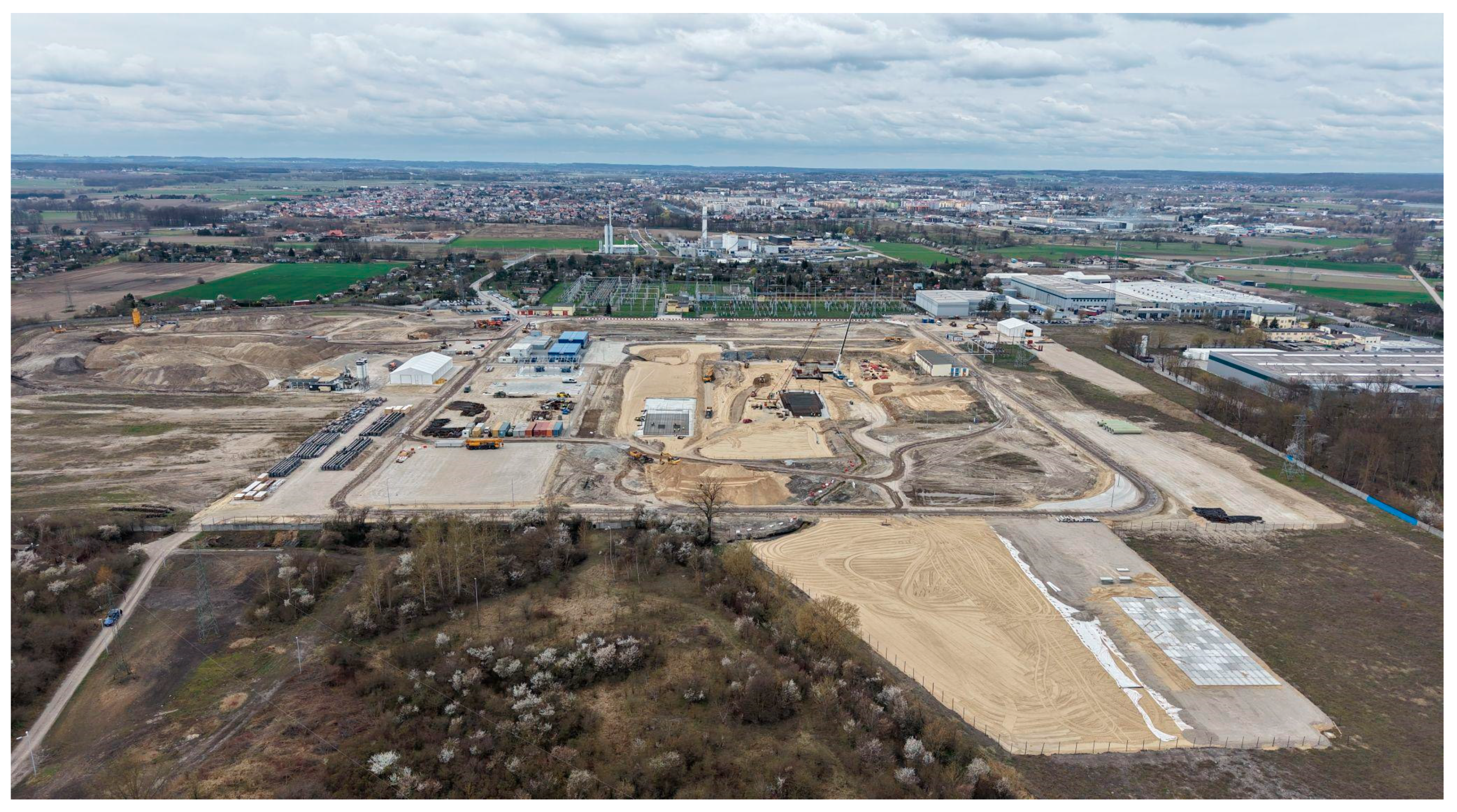
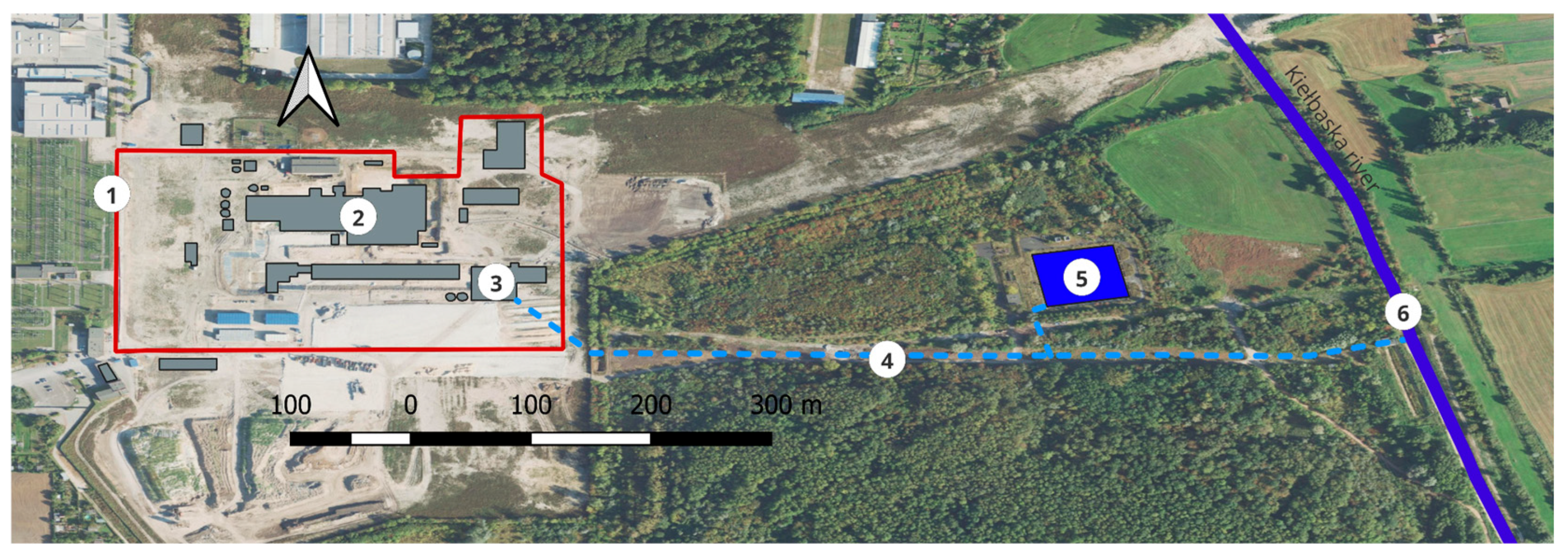
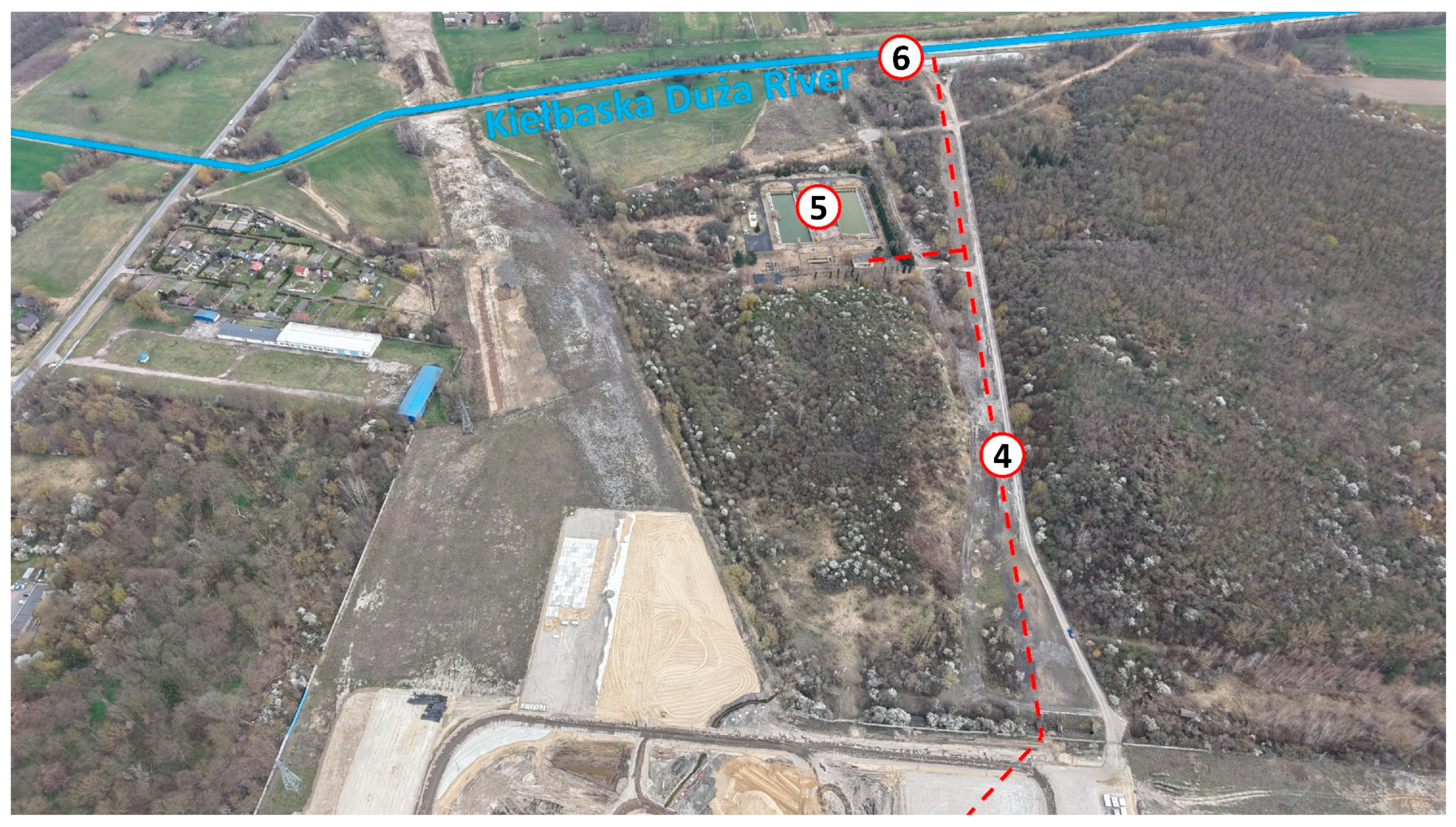


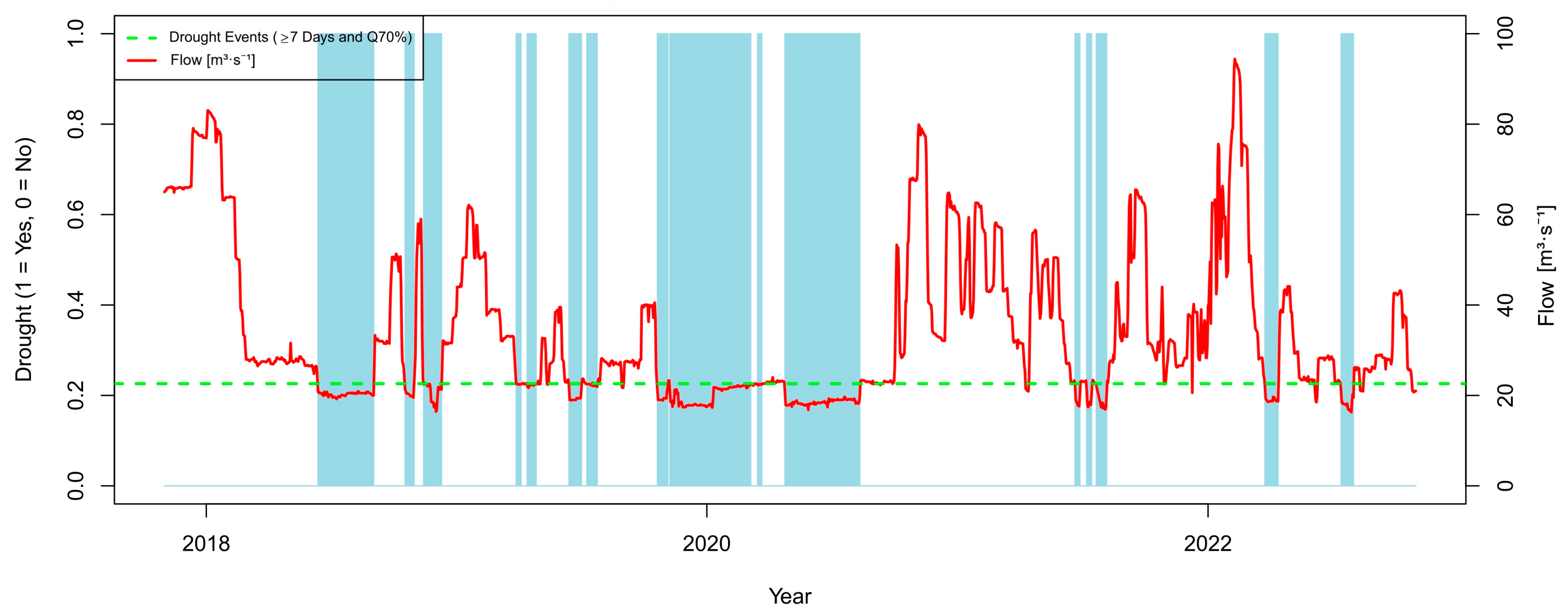
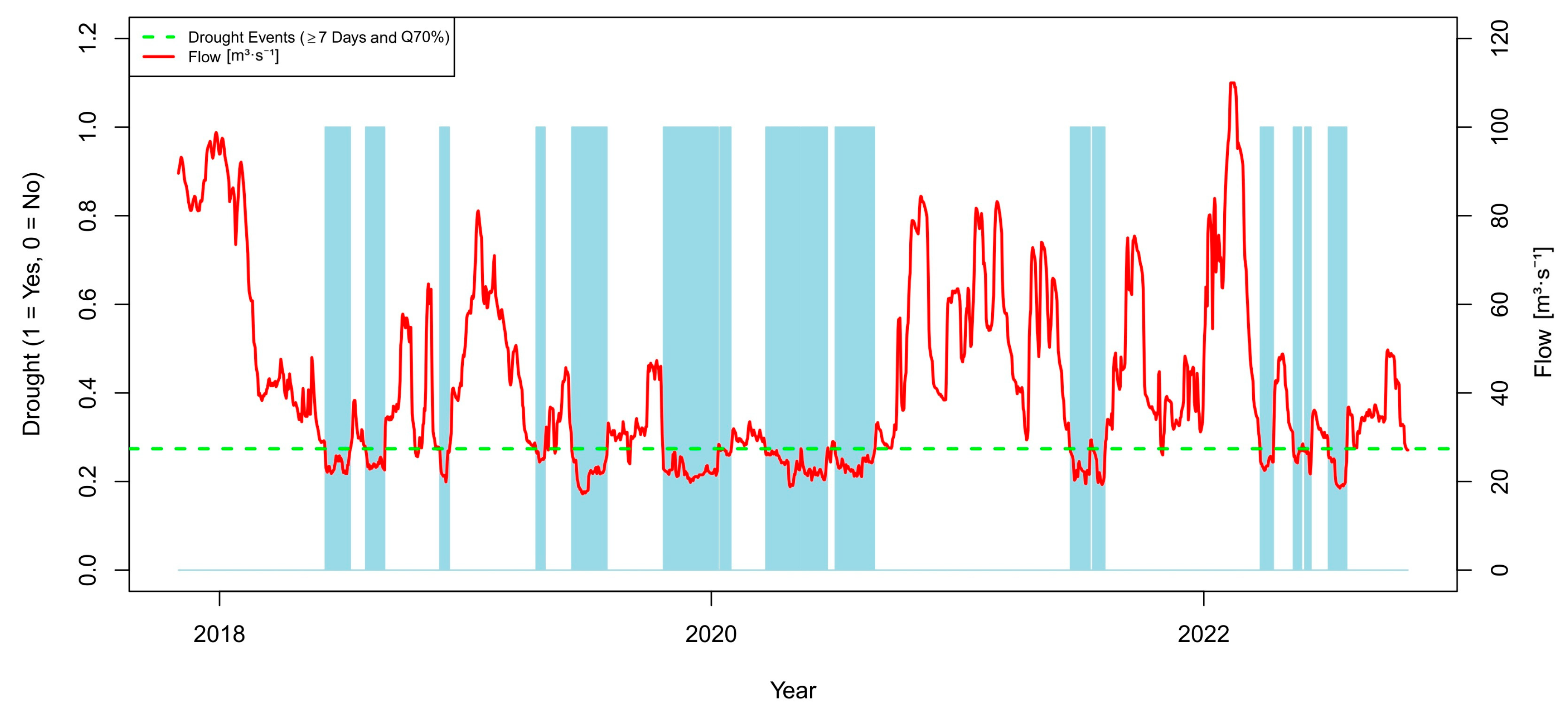
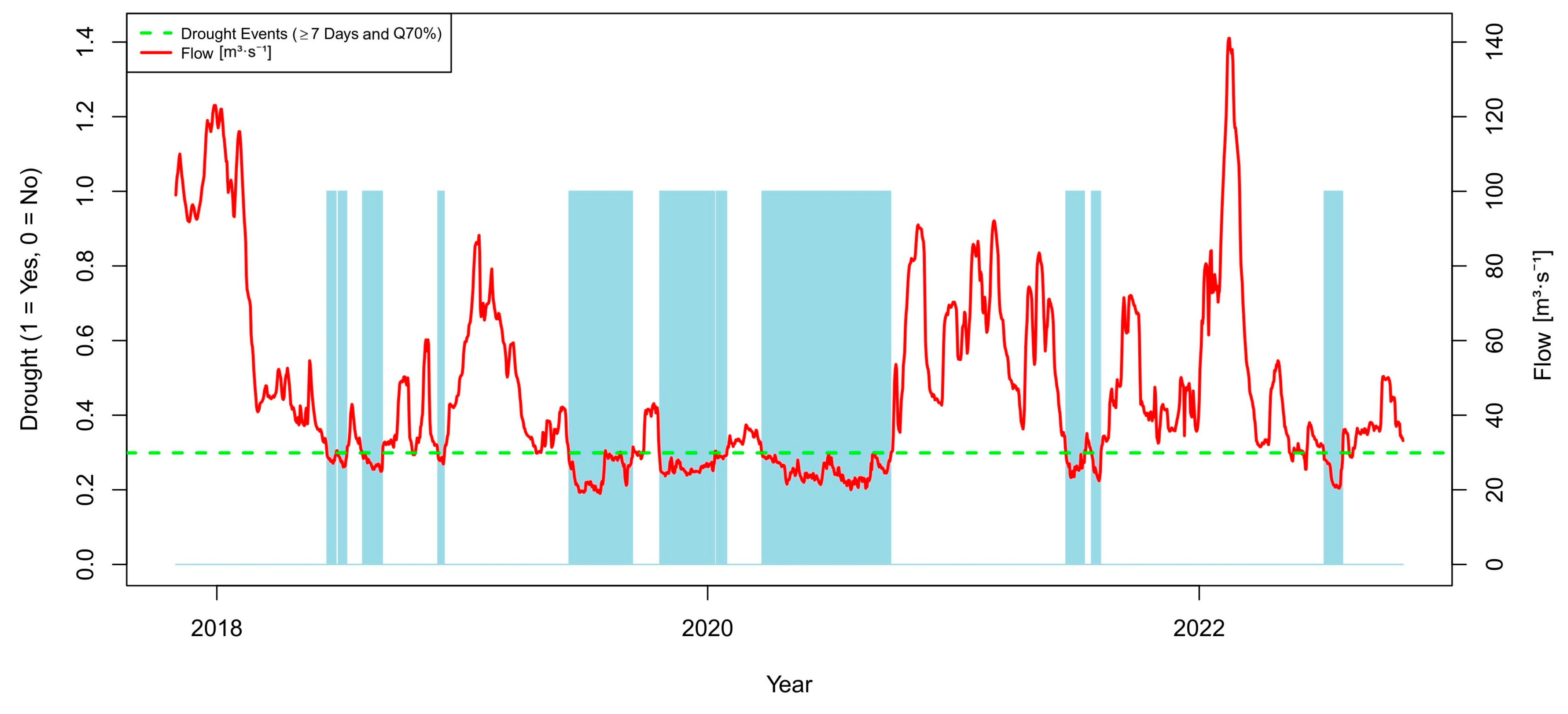
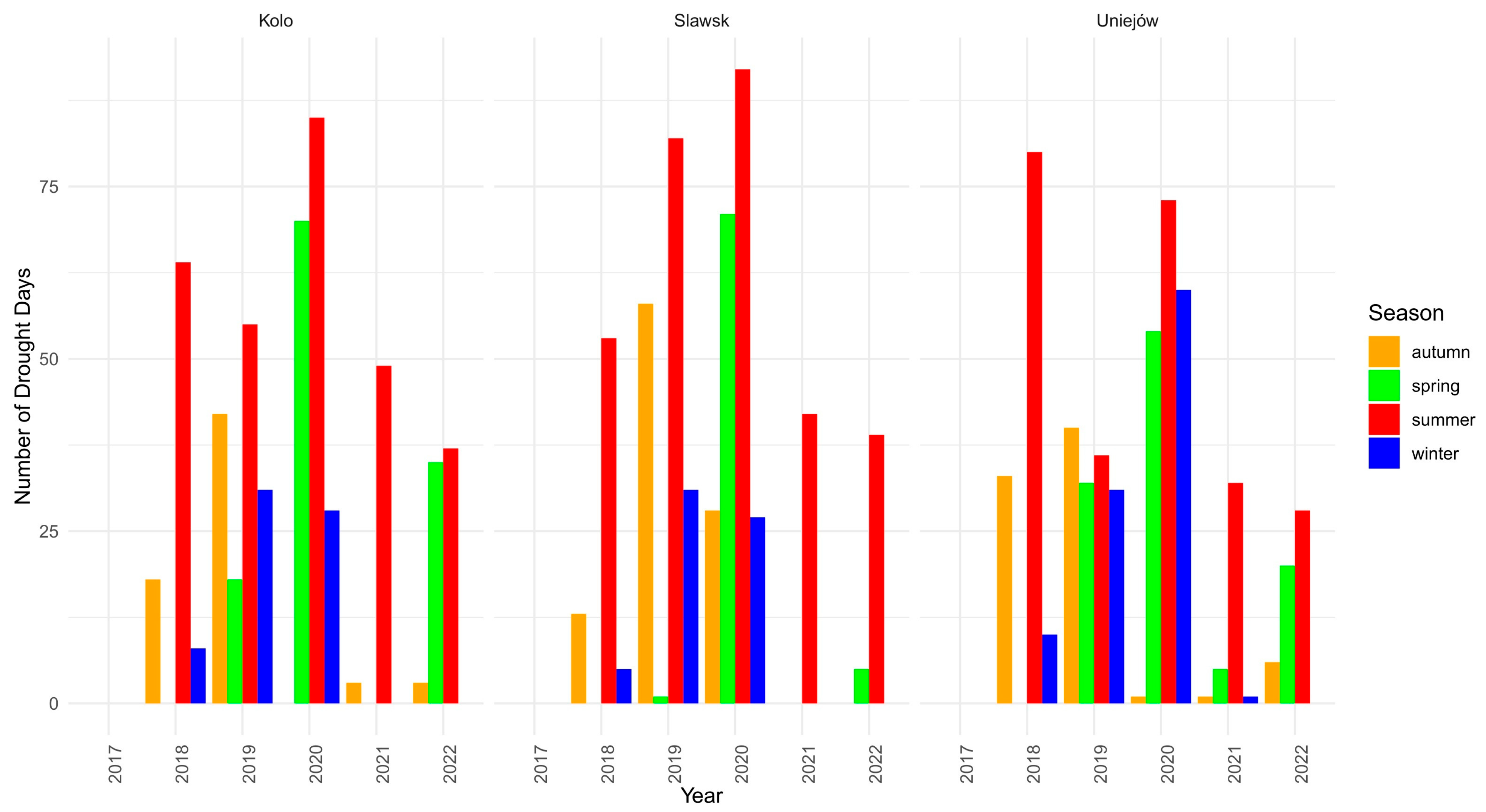
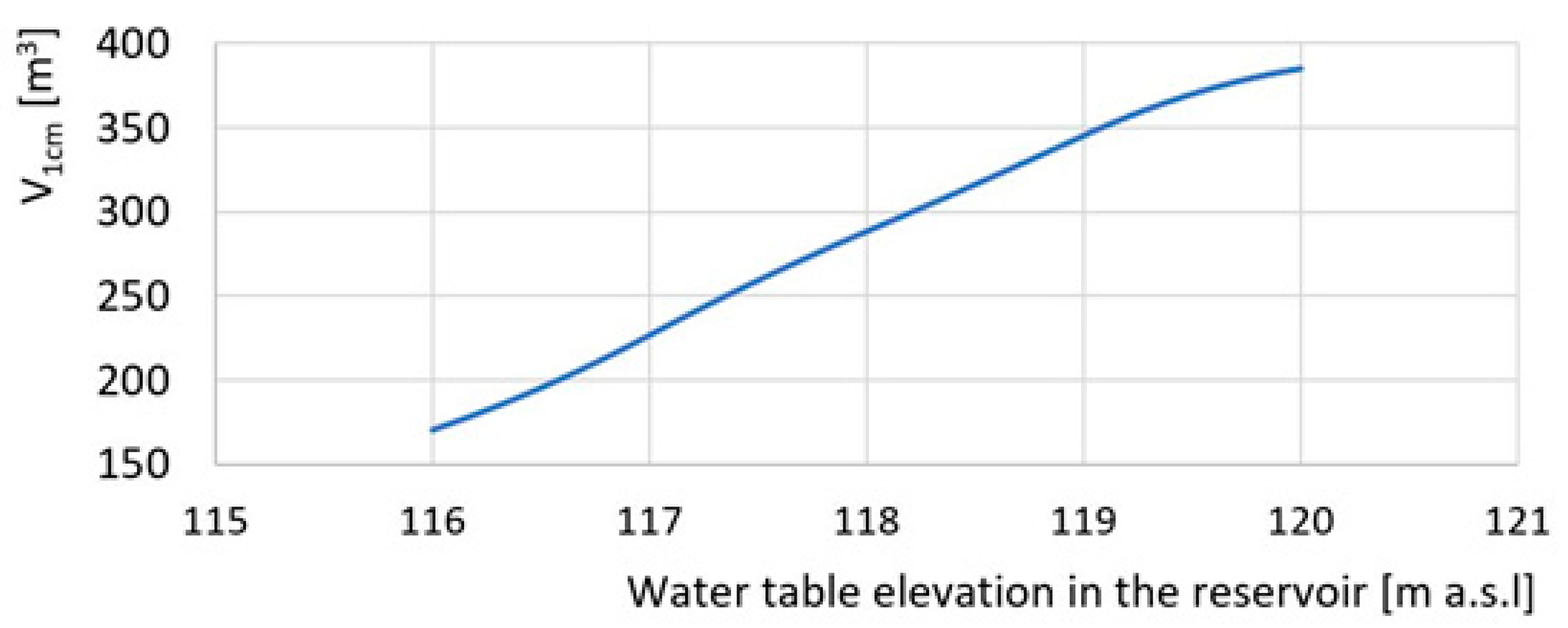
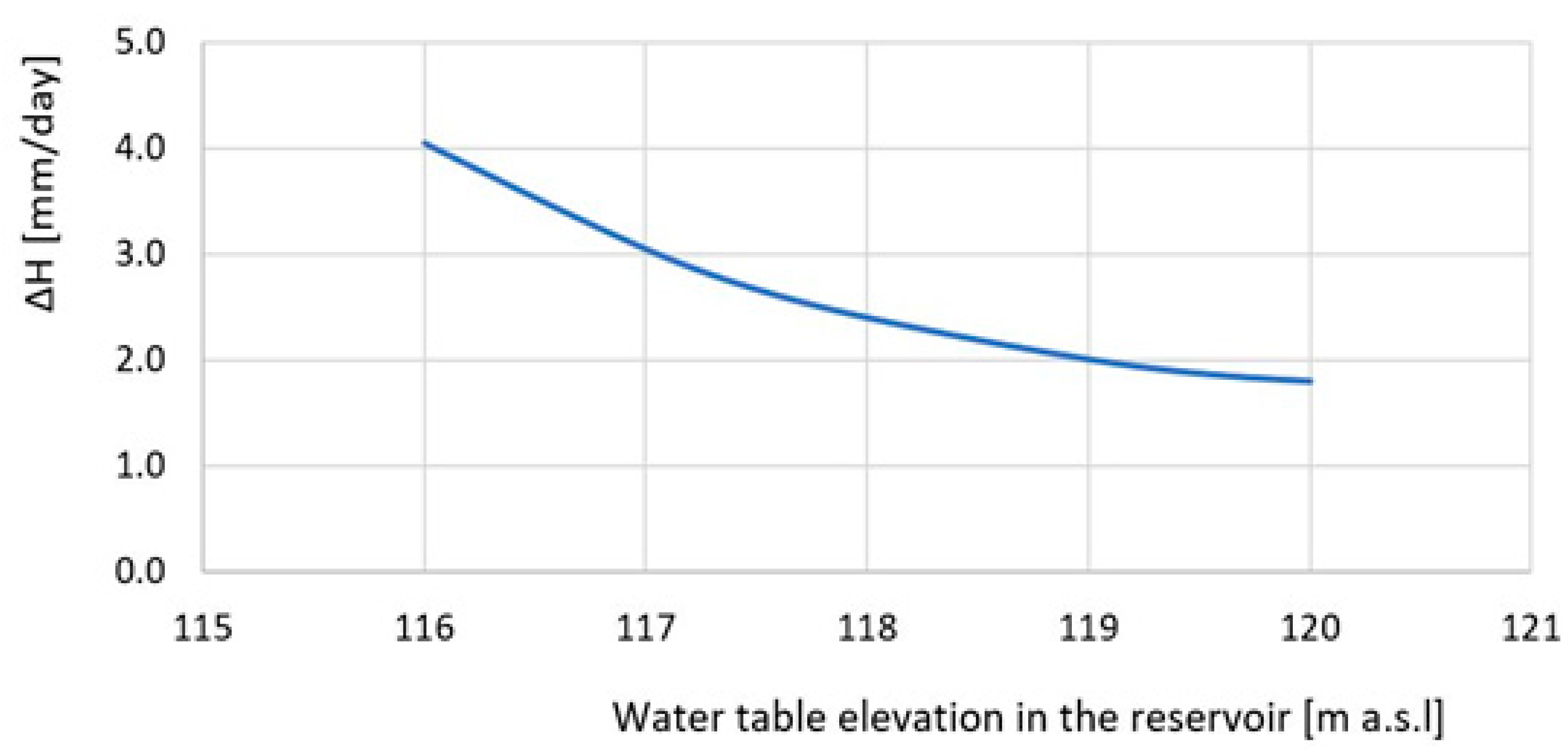
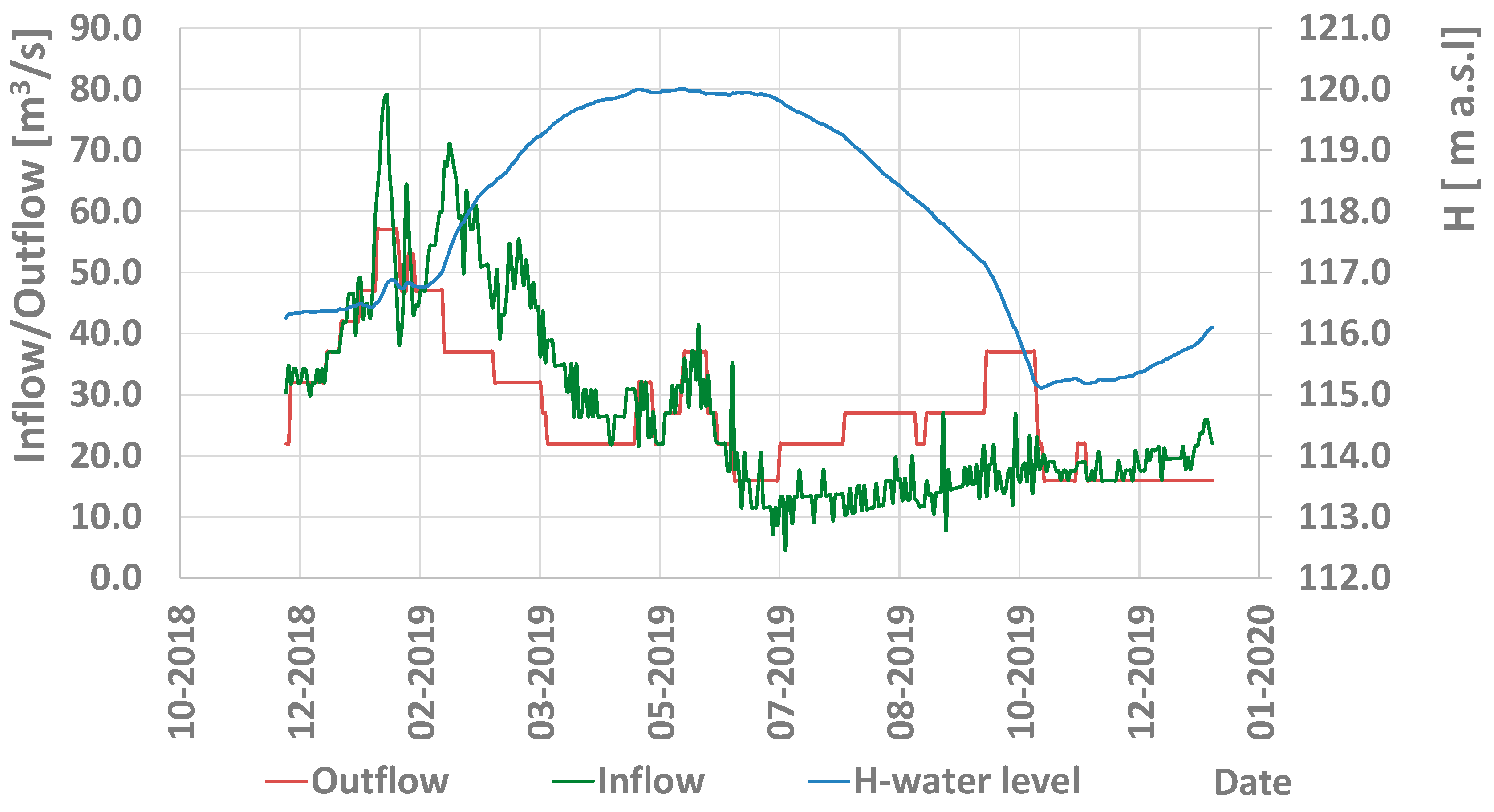
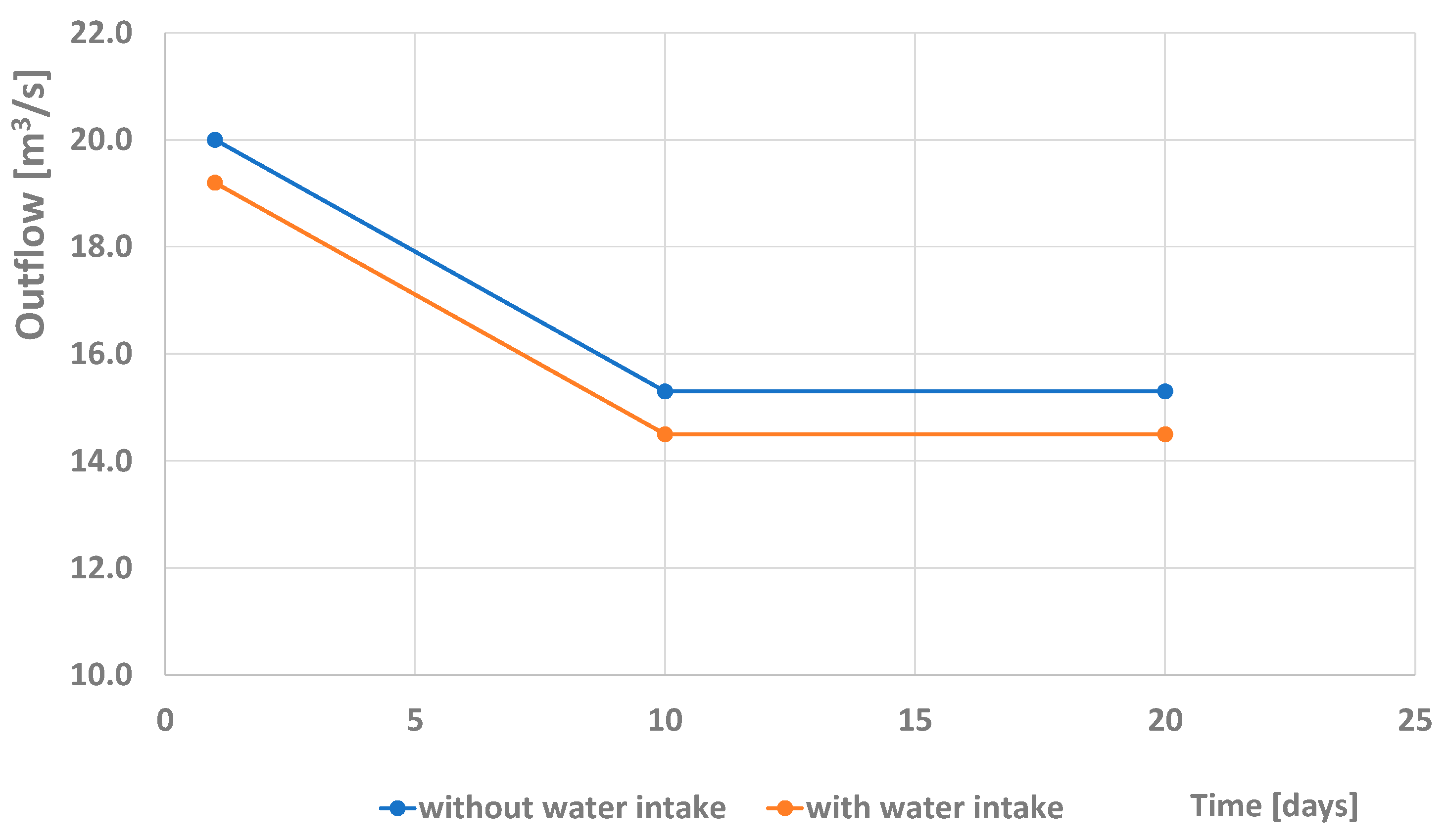
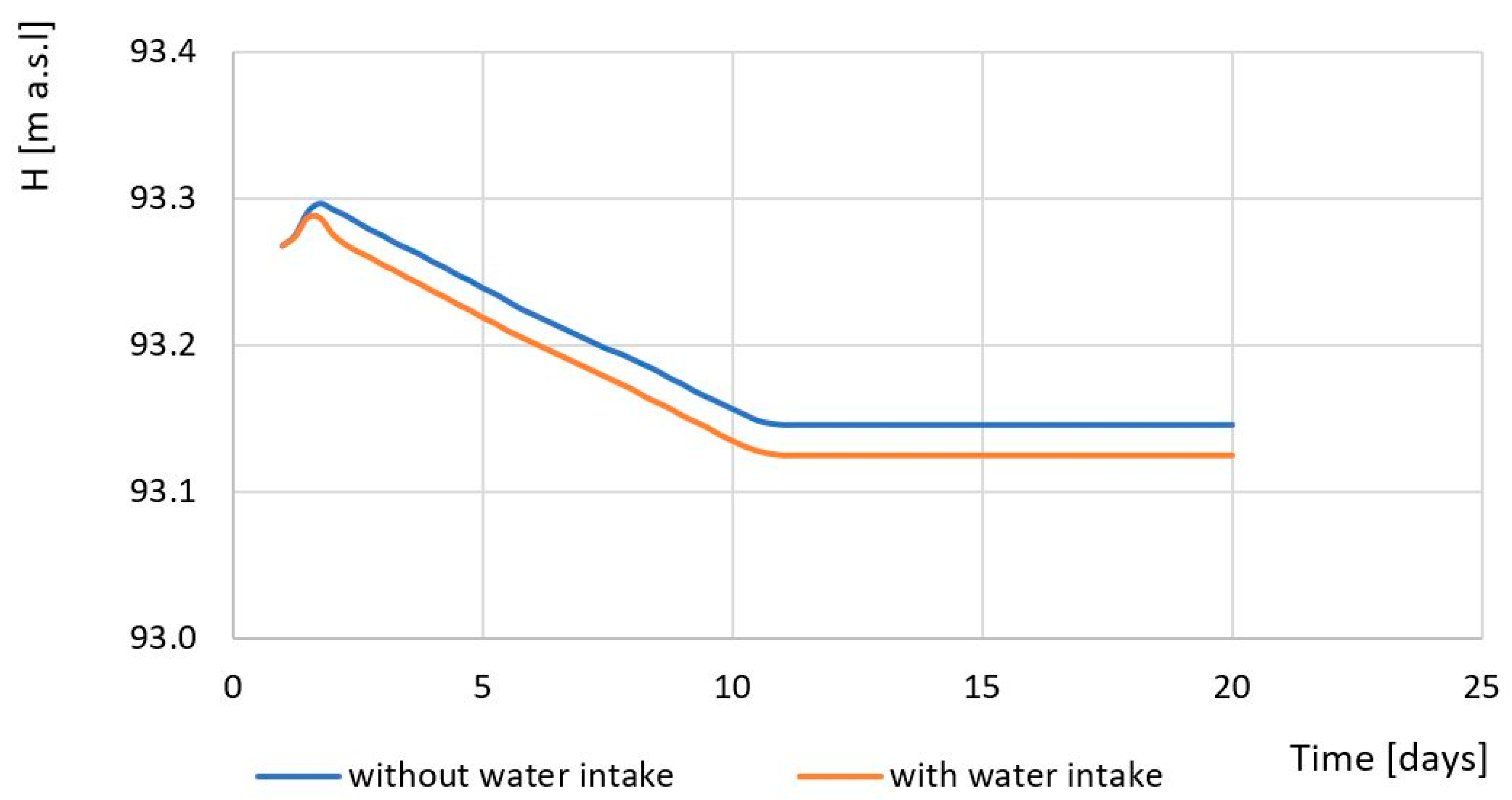
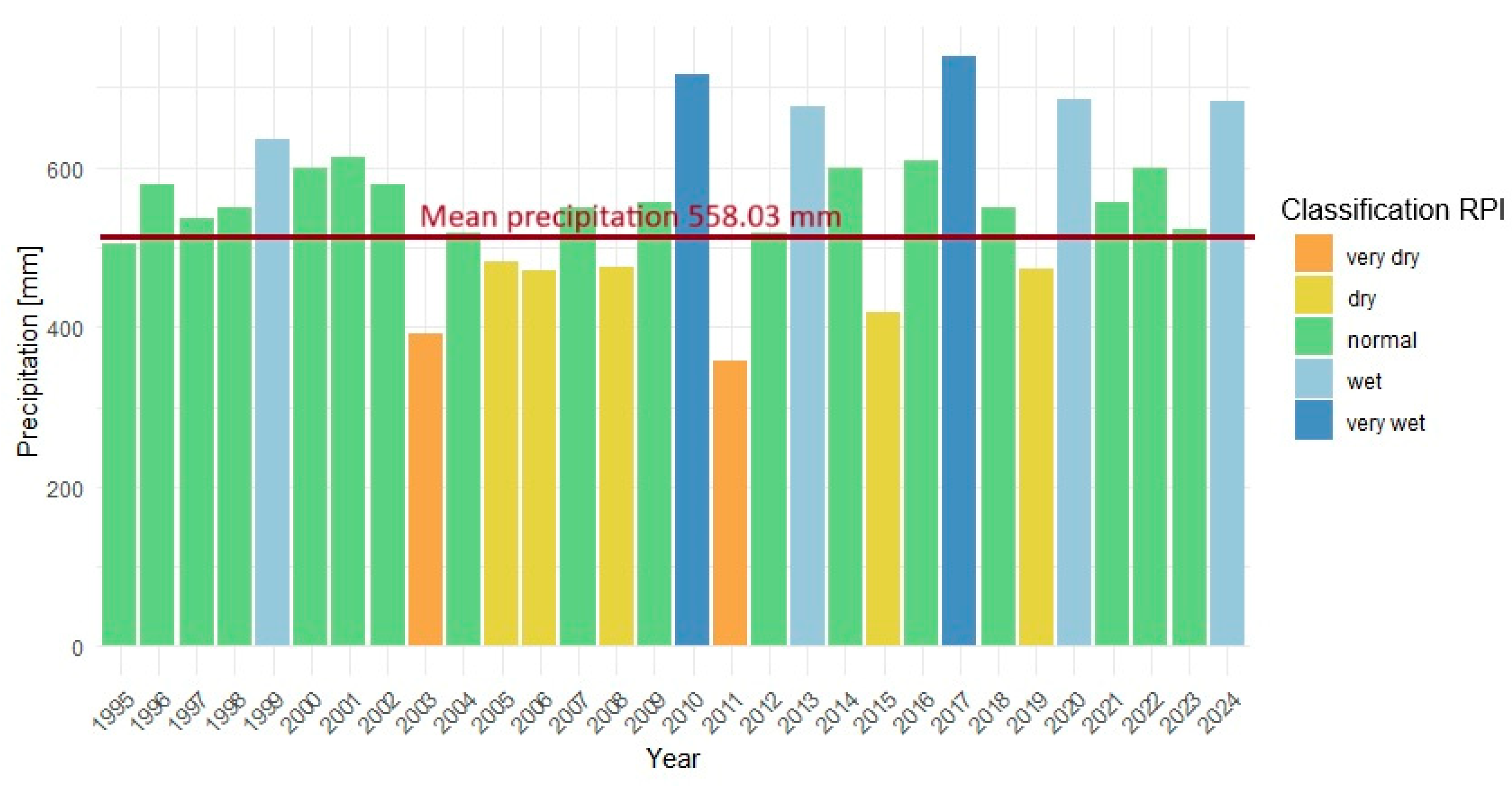
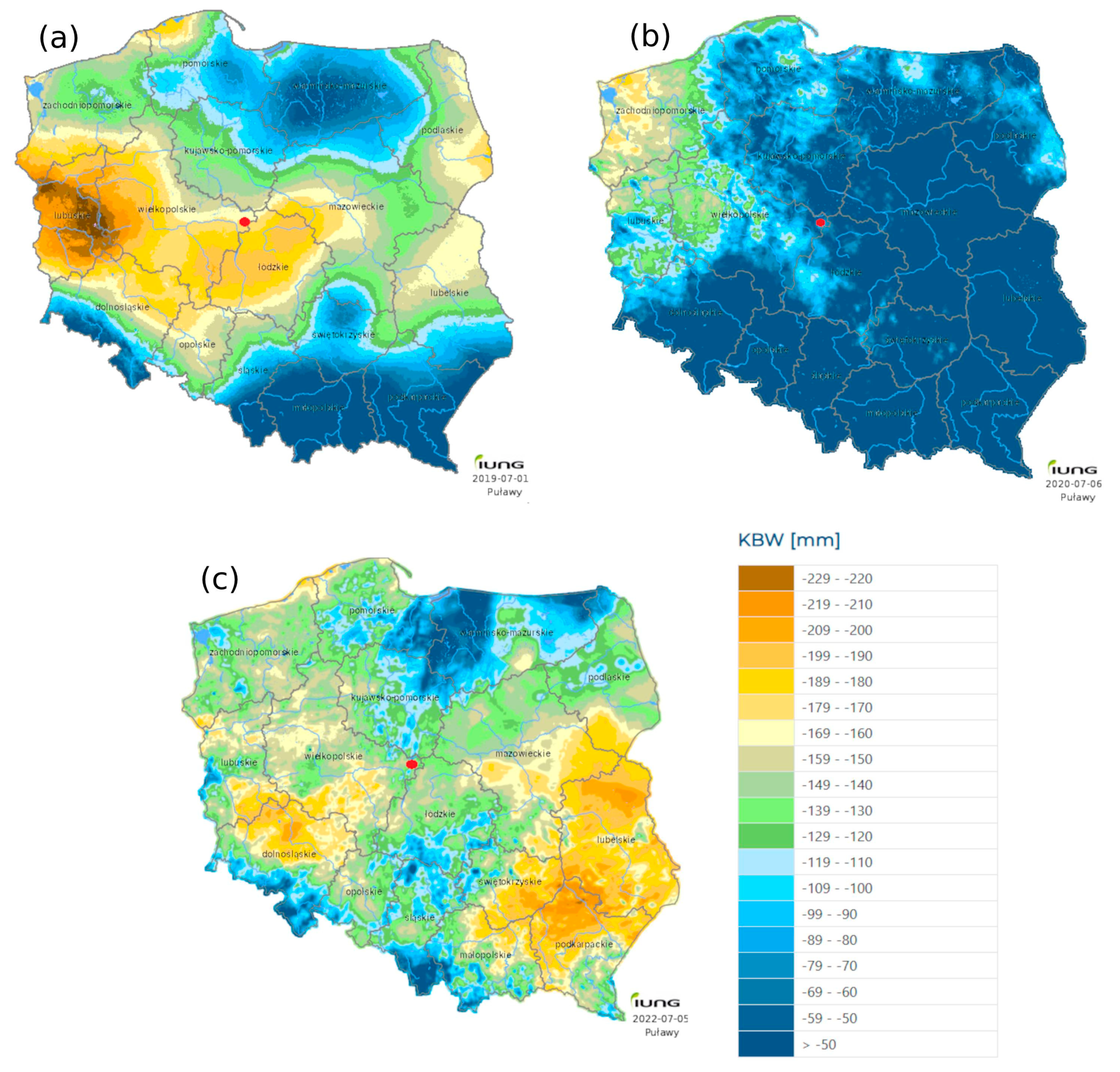
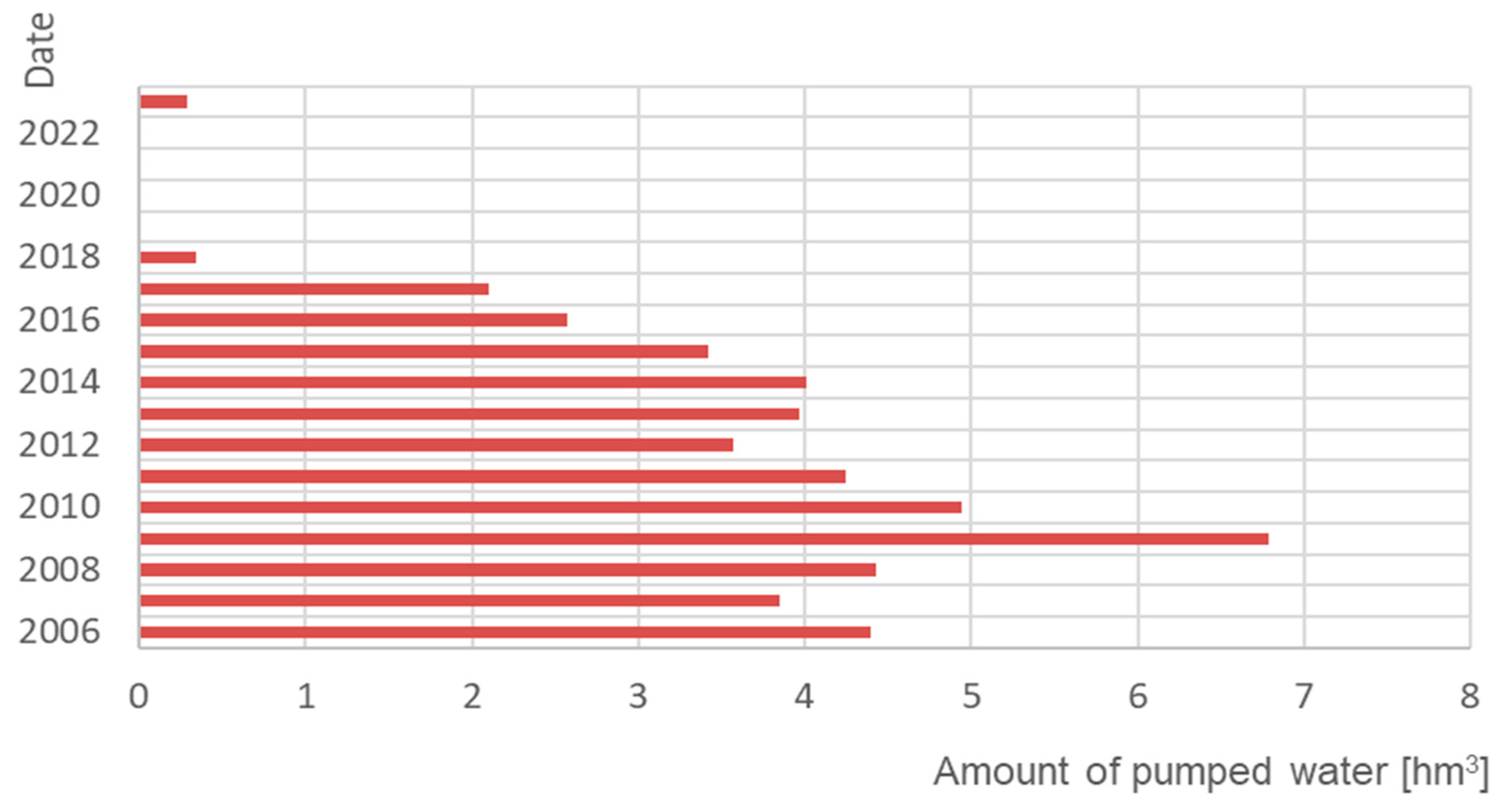
| Characteristic Flows [m3∙s–1] | Water Gauge Profile | ||
|---|---|---|---|
| Uniejów | Koło | Sławsk | |
| NNQ | 11.90 | 17.00 | 17.40 |
| SNQ | 14.68 | 18.48 | 19.92 |
| WNQ | 17.70 | 20.20 | 23.00 |
| NSQ | 22.70 | 27.80 | 29.20 |
| SSQ | 34.00 | 41.74 | 45.90 |
| WSQ | 41.30 | 50.40 | 57.80 |
| NWQ | 62.60 | 79.60 | 50.80 |
| SWQ | 78.24 | 91.16 | 88.38 |
| WWQ | 95.60 | 111.00 | 142.00 |
| Uniejów Q70% = 22.60 m3∙s–1 | ||
|---|---|---|
| Low-Flow Period | Duration (Days) | Range Q m3∙s–1 |
| 13 June 2018–2 September 2018 | 82 | 19.20–22.60 |
| 18 October 2018–31 October 2018 | 14 | 19.50–22.60 |
| 14 November 2018–10 December 2018 | 27 | 16.40–22.60 |
| 14 April 2019–27 April 2019 | 14 | 21.70–22.60 |
| 14 June 2019–2 July 2019 | 19 | 18.90–22.60 |
| 21 October 2019–5 November 2019 | 16 | 18.90–22.60 |
| 8 November 2019–5 March 2020 | 119 | 17.40–22.60 |
| 24 April 2020–11 August 2020 | 110 | 16.80–22.60 |
| 22 July 2021–6 August 2021 | 16 | 16.90–22.60 |
| 25 March 2022–13 April 2022 | 20 | 18.60–22.60 |
| 14 July 2022–1 August 2022 | 19 | 16.30–22.60 |
| Koło Q70% = 27.40 m3∙s–1 | ||
|---|---|---|
| Low-Flow Period | Duration (Days) | Range Q m3∙s–1 |
| 7 June2018–14 July 2018 | 38 | 21.80–27.40 |
| 6 August 2018–3 September 2018 | 29 | 22.60–27.40 |
| 24 November 2018–8 December 2018 | 15 | 19.90–27.40 |
| 16 April 2019–29 April 2019 | 14 | 24.40–27.40 |
| 8 June 2019–30 July2019 | 53 | 17.40–27.40 |
| 22 October 2019–11 January 2020 | 82 | 19.80–27.40 |
| 14 January 2020–30 January 2020 | 18 | 26.90–27.40 |
| 22 March 2020–12 May 2020 | 52 | 18.80–27.40 |
| 14 May 2020–21 June 2020 | 39 | 21.00–27.40 |
| 3 July 2020–30 August 2020 | 59 | 21.10–27.40 |
| 17 June 2021–16 July 2021 | 30 | 19.60–27.40 |
| 20 July 2021–7 August 2021 | 19 | 19.60–27.40 |
| 26 March 2022–14 April 2022 | 20 | 22.60–27.40 |
| 14 May 2022–26 May 2022 | 13 | 24.20–27.40 |
| 31 May 2022–9 June 2022 | 10 | 21.70–27.40 |
| 5 July 2022–1 August 2022 | 28 | 18.50–27.40 |
| Sławsk Q70% = 29.90 m3∙s–1 | ||
|---|---|---|
| Low-Flow Period | Duration (Days) | Range Q m3∙s–1 |
| 14 June 2018–27 June 2018 | 14 | 27.10–29.90 |
| 1 July 2018–13 July 2018 | 13 | 26.40–29.90 |
| 6 August 2018–4 September 2018 | 30 | 25.00–29.90 |
| 26 November 2018–5 December 2018 | 10 | 26.90–29.90 |
| 9 June 2019–1 August 2019 | 54 | 19.00–29.90 |
| 3 August 2019–23 August 2019 | 21 | 21.20–29.90 |
| 25 August 2019–11 September 2019 | 18 | 29.20–29.90 |
| 22 October 2019–11 January 2020 | 82 | 23.70–29.90 |
| 14 January 2020–29 January 2020 | 16 | 29.40–29.90 |
| 22 March 2020–4 September 2020 | 167 | 20.00–29.90 |
| 6 September 2020–29 September 2020 | 24 | 24.50–29.90 |
| 17 June 2021–14 July 2021 | 28 | 23.50–29.90 |
| 25 July 2021–7 August 2021 | 14 | 22.40–29.90 |
| 6 July 2022–2 August 2022 | 28 | 20.40–29.90 |
| Cross-Section of Warta | Water Table Ordinate [m Above Sea Level] Without Recharging | Water Table [m a.s.l.] with Recharging | Maximum Difference in Ordinates [m] | ||
|---|---|---|---|---|---|
| Average | Minimum | Average | Minimum | ||
| 445 + 423 | 93.19 | 93.15 | 93.17 | 93.13 | 0.02 |
| 447 + 769 | 94.16 | 94.13 | 94.14 | 94.13 | 0.02 |
| 451 + 867 | 95.78 | 95.75 | 95.77 | 95.74 | 0.01 |
Disclaimer/Publisher’s Note: The statements, opinions and data contained in all publications are solely those of the individual author(s) and contributor(s) and not of MDPI and/or the editor(s). MDPI and/or the editor(s) disclaim responsibility for any injury to people or property resulting from any ideas, methods, instructions or products referred to in the content. |
© 2025 by the authors. Licensee MDPI, Basel, Switzerland. This article is an open access article distributed under the terms and conditions of the Creative Commons Attribution (CC BY) license (https://creativecommons.org/licenses/by/4.0/).
Share and Cite
Kałuża, T.; Laks, I.; Kanclerz, J.; Janicka-Kubiak, E.; Hämmerling, M.; Zaborowski, S. Hydrological Effects of the Planned Power Project and Protection of the Natura 2000 Areas: A Case Study of the Adamów Power Plant. Energies 2025, 18, 3079. https://doi.org/10.3390/en18123079
Kałuża T, Laks I, Kanclerz J, Janicka-Kubiak E, Hämmerling M, Zaborowski S. Hydrological Effects of the Planned Power Project and Protection of the Natura 2000 Areas: A Case Study of the Adamów Power Plant. Energies. 2025; 18(12):3079. https://doi.org/10.3390/en18123079
Chicago/Turabian StyleKałuża, Tomasz, Ireneusz Laks, Jolanta Kanclerz, Ewelina Janicka-Kubiak, Mateusz Hämmerling, and Stanisław Zaborowski. 2025. "Hydrological Effects of the Planned Power Project and Protection of the Natura 2000 Areas: A Case Study of the Adamów Power Plant" Energies 18, no. 12: 3079. https://doi.org/10.3390/en18123079
APA StyleKałuża, T., Laks, I., Kanclerz, J., Janicka-Kubiak, E., Hämmerling, M., & Zaborowski, S. (2025). Hydrological Effects of the Planned Power Project and Protection of the Natura 2000 Areas: A Case Study of the Adamów Power Plant. Energies, 18(12), 3079. https://doi.org/10.3390/en18123079







